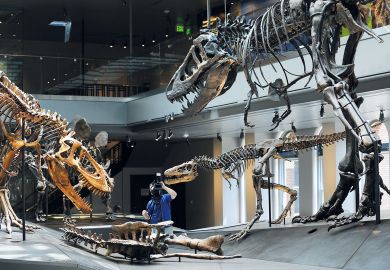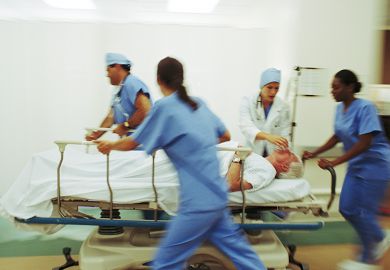The archetypal Greek tragedy involves a hero who is virtuous and respected but is ultimately destroyed by a fatal flaw or error in judgement that has terrible consequences. For audiences, the tragic downfall of a mythic hero provided an opportunity for self-reflection and served to reinforce standards of morality.
The resignation of Marc Tessier-Lavigne as the president of Stanford University has many of the elements of a Greek tragedy, including the opportunity for ethical reflection.
Tessier-Lavigne’s downfall began when Theo Baker, a student journalist at Stanford, received a tip that he was an author of research papers that had been flagged on the website PubPeer for possible image duplication. While investigating the story, Baker was informed by other anonymous sources of even more serious allegations that Tessier-Lavigne had covered up research misconduct arising from his lab when he worked at the San Francisco biotech firm Genentech, where he worked from 2003 to 2011.
An external panel was formed to review the evidence. Although it failed to confirm the allegations involving Genentech, it was able to verify evidence of data manipulation in papers from Tessier-Lavigne’s research groups, published in the journals Cell, Science and Nature in 1999, 2001 and 2004 respectively, as well as multiple errors in a paper published in Nature in 2009. The panel suggested that this might be indicative of suboptimal oversight and management by Tessier-Lavigne rather than direct misconduct, but he was also criticised for failing to correct the literature in a timely manner. Tessier-Lavigne accepted the findings and announced his resignation as the president of Stanford last month.
To journal editors, the type of data manipulation reported by the panel is very familiar. Several years ago, we and our colleague Elisabeth Bik examined digital images from more than 20,000 published research articles. Remarkably, we found that nearly one out of every 25 randomly selected articles contained evidence of inappropriate image duplication. However, we were unable to determine whether the duplications resulted from fraud or honest error. We concluded that it was not possible to judge intent in the absence of the primary data.
Therefore, we followed up this study with an analysis of nearly 1,000 papers from a single journal, Molecular and Cellular Biology, whose editorial staff agreed to investigate each instance of problematic data. We found that one out of 16 papers contained inappropriate image duplication. Most of these resulted from honest errors, but five instances led to retractions. If this is representative of the scientific literature as a whole, more than a million published articles contain problematic data, and hundreds of thousands may warrant retraction.
Notably, we found that the prevalence of problematic images rose sharply in the early 2000s, corresponding to the increasing use of digital image modification software in manuscript preparation. Standards for image modification were not developed until around 2004. This raises the question of whether current standards should be applied to the early papers from Tessier-Lavigne’s group that were flagged. Also relevant to Tessier-Lavigne’s case, we found it very difficult to correct the literature once errors were found; some journals and institutions failed even to respond to our concerns.
Decades of stagnant federal research funding and an overproduction of PhDs relative to the academic job opportunities have created a hypercompetitive environment for students and postdocs, who face uncertain career prospects. A first-author publication in a prestigious journal such as Cell, Nature or Science can be a ticket to a faculty position at a top-tier institution. This may provide an irresistible incentive for a few ambitious young scientists to cut corners or even to commit fraud. Although some competition can provide motivation, we have repeatedly seen that excessive competition can have a corrosive effect on research integrity.
Tessier-Lavigne did the honourable thing by resigning his position as president. He could not serve as an effective institutional leader after his reputation was questioned. However, we do not see anything remarkable about the way he ran his lab. The pressures to succeed reported by his former trainees are, unfortunately, felt by trainees in any high-performing lab. Principal scientists have a limited ability to shield the members of their lab from the intense competitive pressures facing scientists today, and administrative demands on working scientists often preclude close supervision of trainees, especially in large research groups. We suspect that many scientists are saying to themselves that what happened to Tessier-Lavigne could have happened to anyone.
Despite this episode, Tessier-Lavigne remains a respected scientist who has made many contributions to his field, and we hope that he can continue to do so in the years ahead. But we should, nevertheless, take the opportunity to reflect on the broader context of a scientific culture that sometimes seems to value impact over importance and quantity over quality.
Reforms are needed to alleviate the hyper-competition and to restore trust in the integrity of science. As Sophocles, author of some of the greatest Greek tragedies, observed: “Things gained through unjust fraud are never secure.”
Ferric C. Fang is professor of laboratory medicine, pathology and microbiology at the University of Washington School of Medicine. Arturo Casadevall is Bloomberg distinguished professor and Alfred & Jill Sommer professor and chair of the department of molecular microbiology and immunology at Johns Hopkins School of Public Health.
Register to continue
Why register?
- Registration is free and only takes a moment
- Once registered, you can read 3 articles a month
- Sign up for our newsletter
Subscribe
Or subscribe for unlimited access to:
- Unlimited access to news, views, insights & reviews
- Digital editions
- Digital access to THE’s university and college rankings analysis
Already registered or a current subscriber?








